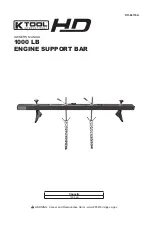
3
2.
Before using a personal fall arrest system, employees must be trained in accordance with the
requirements of OSHA 29 CFR 1910.30 and 1926.503 in the safe use of the system and its
components.
3.
Personal fall arrest and rescue systems, including the SRL, must be inspected prior to each use
for wear, damage, and other deterioration. Defective components must be immediately removed
from service in accordance with the requirements of OSHA 29 CFR 1910.140 and 1926.502.
4.
The complete fall arrest system must be planned (including all components, calculating fall
clearance, and swing fall) before using.
5.
Users must have a rescue plan, and the means at hand to implement it, that provides for
the prompt rescue of the user in the event of a fall, or assures that the user is able to rescue
themselves. A fall over an edge may require special rescue measures.
6.
Store the SRL in a cool, dry, clean environment, out of direct sunlight, when not in use.
7.
After a fall occurs on the system, immediately remove from service until a “competent person”
can make the determination for reuse or disposal.
U
SE
L
IMITATIONS
1.
CAPACITY: SRL’s are designed for users with a capacity (including clothing, tools, etc.) up to 400
lb (181 kg) total working weight.
2.
CORROSION: Do not leave SRL’s in environments where corrosion of metal parts could
take place as a result of vapors from organic materials. Use near seawater or other corrosive
environments may require more frequent inspections to ensure corrosion damage is not affecting
the performance of the product.
3.
CHEMICAL HAZARDS: Solutions containing acids, alkali, or other caustic chemicals, especially
at elevated temperatures, may cause damage to the SRL’s. When working with such chemicals,
frequent inspection of this equipment must be performed. Contact Werner Co. with any questions
concerning the use of the SRL around chemical hazards.
4.
EXTREME TEMPERATURE: SRL’s are designed to be used in temperatures ranging from -40
°
F
to +130
°
F (-40°C to +54°C). Protection should be provided for SRL’s when used near welding,
metal cutting or similar activities. Contact Werner Co. with any questions concerning high
temperature environments.
5.
ELECTRICAL HAZARDS: Use extreme caution when working near high voltage power lines due
to the possibility of electric current fl owing through the SRL or connecting components.
6.
HEALTH: Minors, pregnant women and anyone with a history of either back or neck problems
should not use this equipment.
7.
RESCUE: In the event of a fall over the edge, special rescue measures may be required.
8.
TRAINING: Do not use SRL’s without proper training from a “competent” person as defi ned by
OSHA 29 CFR 1910.140(b) and 1926.32(f).
9.
REPAIRS: Only Werner Co., or persons or entities authorized in writing by Werner Co., may
make repairs or alterations to the equipment.
ANCHORAGE REQUIREMENTS
A
NCHORAGES
All anchorages to which the SRL attaches must meet the requirements of ANSI Z359.2 and OSHA 29
CFR 1910 and 1926.
OSHA states:
Anchorages used for attachment of personal fall arrest equipment shall be independent of any
anchorage being used to support or suspend platforms and capable of supporting at least
5,000 pounds (22.2 kN) per employee attached, or shall be designed, installed, and used as part
of a complete personal fall arrest system which maintains a safety factor of at least two; and
under the supervision of a “qualifi ed” person.
WARNING!
Not all fall protection and rescue components are rated for the same user weight capacity.
Only use components rated for the same weight capacity.
Summary of Contents for Bantam 6
Page 10: ...10 NOTES ...
Page 11: ...11 NOTES ...






























